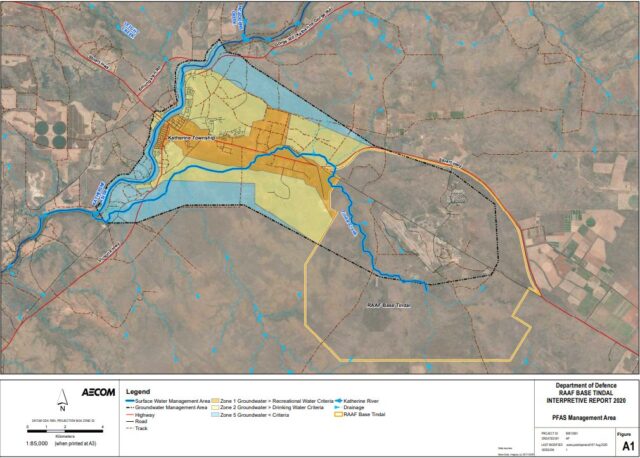Cossack (Northern Territory) – PFAS
https://www.abc.net.au/news/2022-07-05/pfas-found-in-cossack-katherine-water-contamination/101204766
Cossack resident Jens Ambjerg-Peterson wants to know why his property was not tested for PFAS after the chemical, associated with various cancers and other health problems, was detected in his suburb.
He is among residents on Katherine’s south-western outskirts whose sense of security was shattered by last month’s discovery that the chemical is continuing to spread more than half a decade after it was found to be leaching into the Katherine township’s drinking water
Mr Ambjerg-Peterson’s house was outside a PFAS contamination zone that was created after the chemical was discovered in a river by the Department of Defence in 2016, and traced back to the Tindal Royal Australian Air Force Base.
PFAS chemicals were used in firefighting foams at Australian defence bases until the early 2000s.
The lines of the contamination zone have since been redefined, but residents in the area say they have been kept in the dark.
Six private properties within the Cossack area have been monitored under the Ongoing Monitoring Plan since 2019,” a department spokeswoman said.
She said another nine private properties were added to the monitoring program in 2021, bringing the total to 15.

Properties left untested
According to the the most recent Census, there were 625 homes in Cossack and more than 1,200 residents.
Mr Ambjerg-Peterson said his bore had never been tested for PFAS.
“The boundary is the bitumen road at the front of my house … it’s been a designated line in the sand and that line is 4 metres from my bore,” he said.
He said most properties in the area were dependent on bore water for irrigation and drinking.
Dangers of PFAS
The Commonwealth’s Expert Health Panel for PFAS said there was limited-to-no evidence of human disease or other clinically significant harm resulting from PFAS exposure but as a precaution, recommends minimal exposure to PFAS wherever possible.
In the US, renowned activist Erin Brockovich said research was uncovering strong links to reproductive issues and some cancers.
A Four Corners investigation in 2017 revealed the Defence Department knew about the dangers of the firefighting foam as early as 1987, but continued to use it.
Mr Ambjerg-Peterson said lingering questions and uncertainty about whether or not his water was safe to drink were rattling.
The Department of Defence spokeswoman said PFAS had been detected at eight private properties in the Cossack area, and three properties had been provided alternative drinking water.
However, questions on what levels of PFAS had been found at the properties and why dozens of residents in the area had not had their bores tested were not answered.
“Defence is unable to provide results of sampling at individual properties due to privacy issues,” she said.
She said the department assessed samples from groundwater, surface water and biota, which were primarily fish.
“Monitoring occurs on both public and private property,” she said.
She said the monitoring plan would be reviewed regularly and the department would update the frequency of sampling or the locations in consultation with the NT Environment Protection Authority as required.
‘We don’t know where it has moved’
Fellow Cossack residents Sander Klarenbeek and Lynnvette Rebeiro said they feared they were drinking contaminated water.
They questioned why their property also had not been tested for PFAS.
The Department of Defence held a meeting in Katherine in June to update residents on where the chemical had spread.
The meeting was attended by at least a dozen residents. Mr Klarenbeek and Ms Rebeiro said they were not aware the meeting was on.
“We don’t know where it has moved. We don’t know if our bores are affected. We don’t know which bores are affected,” Mr Klarenbeek said.
They said their preceding notion of safety had been replaced by health fears and distress over potential property devaluation.
Bruce Francias, who lives inside the contamination zone a few streets away, said the department tested his bore for PFAS about two years ago.
Results came back negative but it was a different story just 100 metres away at his neighbour’s property.
“It was positive for PFAS and they were given a rainwater tank,” he said.
Mr Francais was at last month’s meeting, and after hearing the chemical had spread further through his suburb, he became alarmed.
“Considering my neighbour tested positive, I would have thought my property would have been looked at again,” he said.
“A lot can happen in 18 months.”
Lack of information sparks rumours
University of Queensland communications expert Kelly Fielding said poor communication could decay trust with the community and cause an “information vacuum”.
She said it was critical when dealing with potential hazards or health risks to communicate “early, often and fully”.
“What can fill that vacuum is misinformation and rumour,” she said.
“For the community members themselves, what this lack of communication does is it makes them feel very uncertain, much more worried than they might need to be because they don’t have good, accurate information.
She said it made it harder for people to work out what precautions they needed to be taking.
“That uncertainty, the worry, the concern that they might have about what’s happening, [whether they are] at risk … is my family at risk … that has a big impact on people’s lives,” she said.
